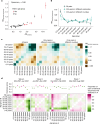Fine-scale patterns of SARS-CoV-2 spread from identical pathogen sequences
- PMID: 40044856
- PMCID: PMC11964829
- DOI: 10.1038/s41586-025-08637-4
Fine-scale patterns of SARS-CoV-2 spread from identical pathogen sequences
Abstract
Pathogen genomics can provide insights into underlying infectious disease transmission patterns1,2, but new methods are needed to handle modern large-scale pathogen genome datasets and realize this full potential3-5. In particular, genetically proximal viruses should be highly informative about transmission events as genetic proximity indicates epidemiological linkage. Here we use pairs of identical sequences to characterize fine-scale transmission patterns using 114,298 SARS-CoV-2 genomes collected through Washington State (USA) genomic sentinel surveillance with associated age and residence location information between March 2021 and December 2022. This corresponds to 59,660 sequences with another identical sequence in the dataset. We find that the location of pairs of identical sequences is highly consistent with expectations from mobility and social contact data. Outliers in the relationship between genetic and mobility data can be explained by SARS-CoV-2 transmission between postcodes with male prisons, consistent with transmission between prison facilities. We find that transmission patterns between age groups vary across spatial scales. Finally, we use the timing of sequence collection to understand the age groups driving transmission. Overall, this study improves our ability to use large pathogen genome datasets to understand the determinants of infectious disease spread.
© 2025. The Author(s).
Conflict of interest statement
Competing interests: A.L.G. reports contract testing from Abbott, Cepheid, Novavax, Pfizer, Janssen and Hologic, research support from Gilead, and salary and stock grants for LabCorp, an immediate family member, outside of the described work. The other authors declare no competing interests.
Figures













Update of
-
Fine-scale spatial and social patterns of SARS-CoV-2 transmission from identical pathogen sequences.medRxiv [Preprint]. 2024 Nov 7:2024.05.24.24307811. doi: 10.1101/2024.05.24.24307811. medRxiv. 2024. Update in: Nature. 2025 Apr;640(8057):176-185. doi: 10.1038/s41586-025-08637-4. PMID: 38826243 Free PMC article. Updated. Preprint.
References
-
- Baele, G., Dellicour, S., Suchard, M. A., Lemey, P. & Vrancken, B. Recent advances in computational phylodynamics. Curr. Opin. Virol.31, 24–32 (2018). - PubMed
MeSH terms
Grants and funding
LinkOut - more resources
Full Text Sources
Medical
Miscellaneous

